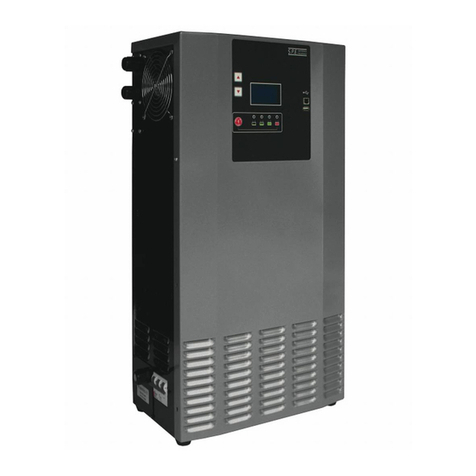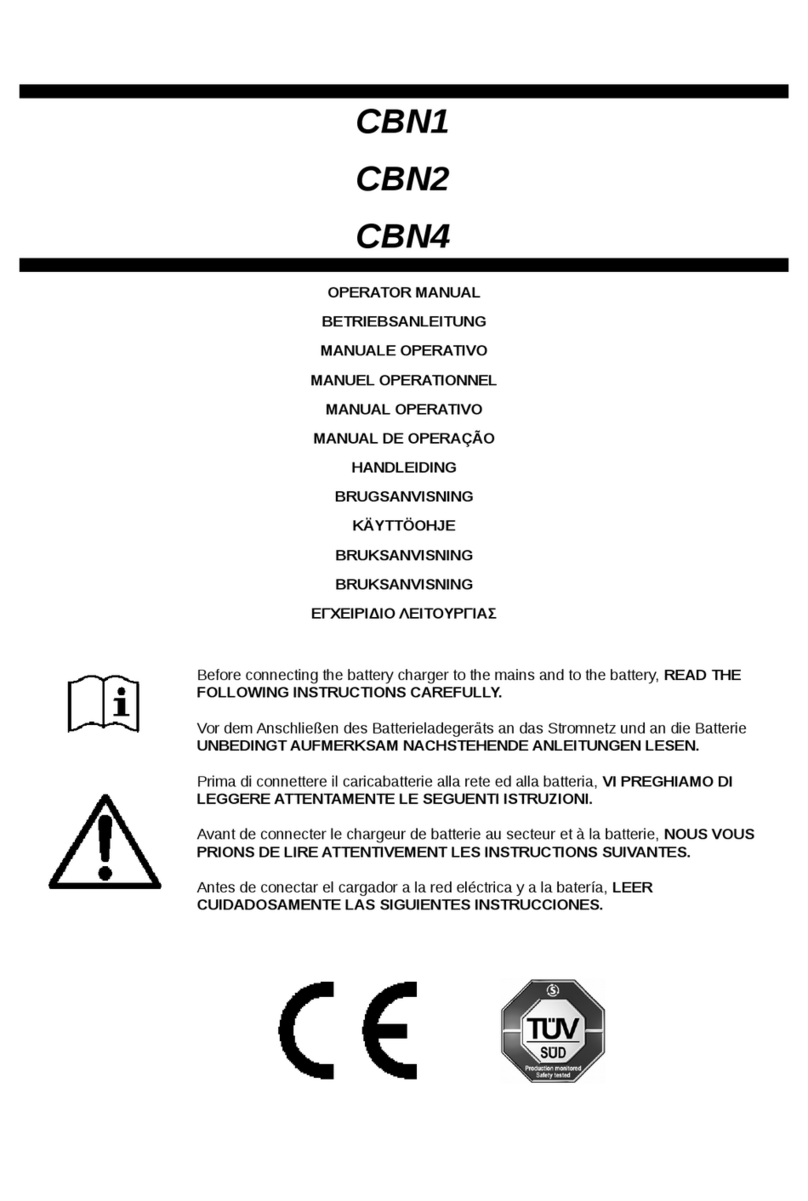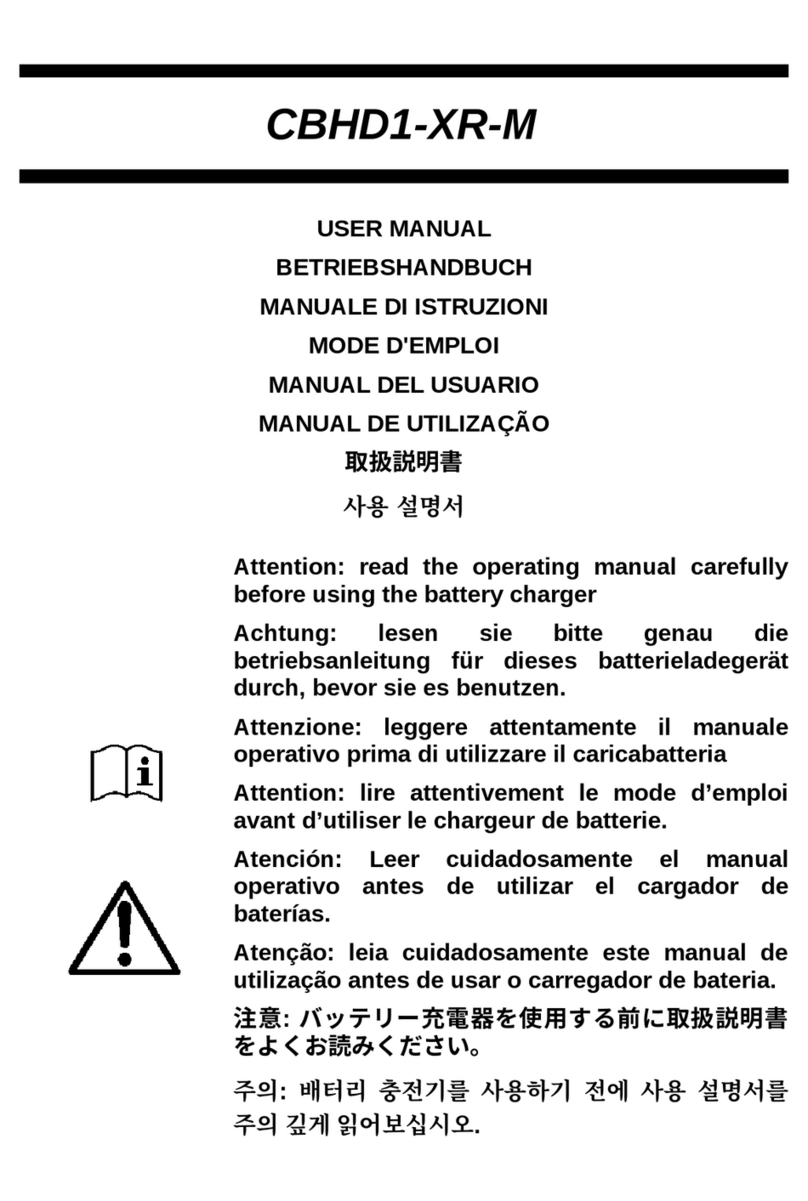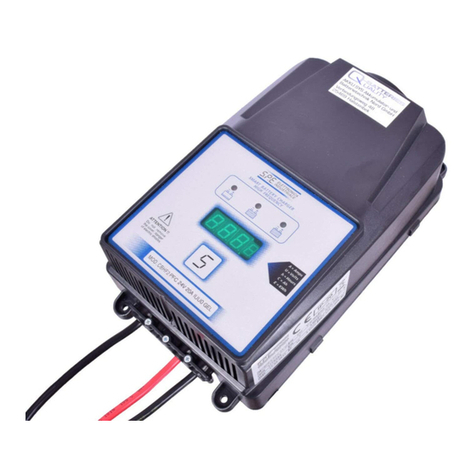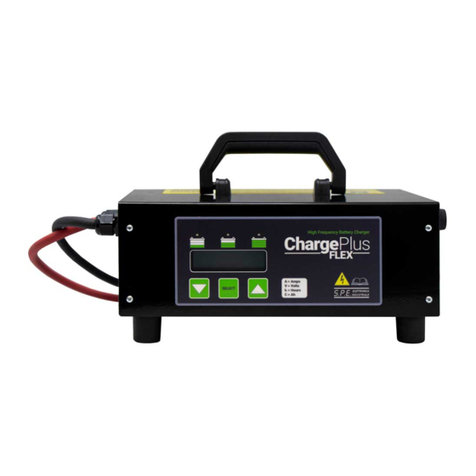S.P.E. STELVIO1800 User manual

STELVIO1800
USER MANUAL
MANUALE D’ISTRUZIONI
Before connecting the battery charger to the mains and to the battery, READ THE
FOLLOWING INSTRUCTIONS CAREFULLY.
Prima di connettere il caricabatterie alla rete ed alla batteria, VI PREGHIAMO DI
LEGGERE ATTENTAMENTE LE SEGUENTI ISTRUZIONI.

Important safety instructions. Keep these instructions. This manual contains
important instructions for the safety of the user and operation of the device.
GENERAL WARNINGS
1) Before each use of the battery charger the instructions set out below must be carefully read and abided by.
2) The failure to follow these instructions and /or errors in installing or using the battery charger could lead to
endangering the operator and /or damaging the device, voiding the manufacturer's guarantee.
3) The battery charger cannot be used as a component in systems which provide life support and/or medical devices,
without explicit written authorization from S.P.E. ELETTRONICA INDUSTRIALE.
4) The rating label must be visible after installation.
CHILDREN
5) This appliance can be used by children aged from 8 years and above and persons with reduced physical, sensory
or mental capabilities or lack of experience and knowledge if they have been given supervision or instruction
concerning use of the appliance in a safe way and understand the hazards involved. Children should be supervised
to ensure that they do not play with the appliance. Cleaning and user maintenance shall not be made by children
without supervision.
WHERE TO INSTALL
6) Never place the battery charger in the immediate vicinity of the battery in order to prevent gases produced and/or
emitted by the actual battery during charging corroding and/or damaging the battery charger. Place the battery
charger as far away from the battery as the length of cables permits.
7) Do not install the battery charger in a closed space or in such a way as to somehow prevent ventilation. For units
equipped with fans, at least 30 mm clearance must be left around the vents. In order to facilitate the heat exchange
of the battery charger it must be positioned vertically, exploiting the fixture holes (where provided).
8) Do not use the battery charger outdoors.
9) Do not expose the battery charger to rain, water splashes or steam.
10) Do not install the battery charger in caravans and / or similar vehicles.
11) Do not install the battery charger near any heat sources or in areas with high concentrations of dust.
12) Do not install the battery charger near any potential sources of flammable material, for example methane gas
pipes or fuel depots (petrol, kerosene, ...).
13) Do not place and/or fit the battery charger onto surfaces manufactured out of combustible materials, like wooden
shelves or walls.
BATTERIES
14) Follow the specific safety instructions provided by the battery manufacturer carefully, for example, whether or not
to remove cell caps during charging and the recommended charge rates.
15) Working in the vicinity of a lead-acid battery is dangerous, as batteries generate explosives gases during
charging. Therefore smoking and/or generating open flames and/or sparks must be avoided.
16) Never charge a frozen battery.
17) Batteries must be charged in specific, well-ventilated areas.
18) In order to reduce risk of injury only charge Lead–Acid, GEL or AGM type, Lithium Polymer or Lithium Ion
batteries. Do not charge other types of rechargeable or non-rechargeable batteries as they could explode causing
damage and/or injury.
FURTHER SPECIFICATIONS FOR LITHIUM BATTERIES
19) In order to charge Lithium Polymer and Lithium Ion batteries, a BMS (Battery Management System) must always
be used, comprising an active and passive safety system, in compliance with safety regulations in force.
20) The possibility of the BMS acting directly on the battery charger operation during cell balancing phases rules out,
for any reason whatsoever, that the battery charger is held directly responsible should damage caused to the battery,
or even a fire or an explosion, be due to an error in the BMS software.
21) The faculty offered by the materials produced by S.P.E. ELETTRONICA INDUSTRIALE to select different levels
of voltage for charging, is entrusted to the control and supervision of the end user and S.P.E. ELETTRONICA
INDUSTRIALE is not liable for any consequences resulting from the selection of the incorrect level of voltage. If in
doubt, the user should ask a qualified professional for clarification.
22) The battery charger tolerance thresholds, as far as levels of over-voltage and overcharging are concerned, are
used only for the safeguarding of the systems of the same and have no safety functions for the battery itself, the
safety of which depends solely on the BMS, even when the battery charger is connected to the battery, whether the
latter is being charged or not.
23) Should the client want to use the battery charger on a specific on-board system and in general in any cases of
special usage, it is the client's responsibility to inform S.P.E. ELETTRONICA INDUSTRIALE, so that the latter can
draw up any necessary recommendations. In this case, the client must provide S.P.E. ELETTRONICA INDUSTRIALE

with all designs, diagrams and descriptive material necessary. S.P.E. ELETTRONICA INDUSTRIALE cannot be held
responsible for any damage resulting from the use of the battery charger after opening it and/or modifying it and/or
inserting it into other systems.
24) Under no circumstances can S.P.E. ELETTRONICA INDUSTRIALE be held responsible for the malfunctioning of
the batteries or the incineration/explosion of these, in so much as the safety of the battery is the task of the BMS and
not of the battery charger.
CHECKING CABLES, GRID, EARTHING
25) Do not transport the battery charger by pulling on the cables as they could be damaged.
Use the handles on the battery charger, if provided.
26) Before using the battery charger, check that the sleeving on the mains cable and battery cables is in good
condition. Should one of the cables be damaged, have it replaced by a S.P.E. ELETTRONICA INDUSTRIALE
qualified technician.
27) Check that the input voltage of the battery charger given on the data plate is in line with the voltage available.
28) Check the compatibility of the mains plug supplied with the battery charger: the use of adaptors is not
recommended. This charger is provided with cord set for connection to outlets operating at nominal 230 Volts (or 240
Volts as appropriate). If the input plug does not fit the power outlet, contact SPE ELETTRONICA INDUSTRIALE for
the proper cord set terminating in an attachment plug of the proper configuration for the power outlet.
29) The battery charger must be plugged into a socket fitted with an earth wire. Should the socket not be equipped
with an earth connection, do not use the device before having a suitable socket installed by a qualified technician.
30) The power socket to which the battery charger is to be connected must be protected by an electrical device by
law (fuse and/or automatic cut-out), capable of absorbing an electrical current equalling the absorption of current
stated on the matriculation number of the battery charger, increased by 10%.
31) Do not open the battery charger as there are no parts which can be serviced and/or replaced by the user. Only
specialized personnel, authorized by S.P.E. ELETTRONICA INDUSTRIALE may carry out servicing which involves
opening the actual device. Electrical/electronic components inside may cause electric shocks even if the device is not
plugged in.
CHECKING BATTERY CHARGER OPERATION AND CURVE
32) Before charging, make sure that the battery charger is in line with the voltage of the battery, that the charging
current suits the capacity of the battery and that the selected charging curve (for lead-acid batteries, or for airtight
GEL or AGM type batteries, Lithium Polymer or Lithium Ion batteries) is correct for the type of battery to be charged.
33) We recommend fitting a fuse between battery charger and battery. The fuse must be installed along the
connection to the positive terminal of the battery. The rating of the fuse must be proportionate to the nominal output
current of the battery charger, the diameter of cable used and the environment in which it is to be installed.
34) We recommend unplugging it from the mains supply before connecting and disconnecting batteries.
35) During normal operation of the battery charger, the external surface may become hot and may remain so for a
certain period of time after it has been switched off.
36) The battery charger needs no special maintenance, only regular cleaning procedures, to be carried out according
to the type of working environment. Cleaning procedures should only be carried out on the external surface of the
battery charger. Before starting any cleaning procedures, the mains supply cable and battery cables must be
unplugged. Do NOT use water and/or detergents in general and/or pressure washers of any kind when carrying out
cleaning.
37) If safe operation of the battery charger can no longer be ensured, stop the device and ensure that it cannot be
put back into operation.
38) The specifications set out in this manual are subject to change without any notice. This publication replaces any
previously supplied information.
39 The battery terminal not connected to the chassis has to be connected first. The other connection is to be made to
the chassis, remote from the battery and fuel line. The battery charger is then to be connected to the supply mains;
After charging, disconnect the battery charger from the supply mains. Then remove the chassis connection and then
the battery connection.
Battery type = xxxxAh C5 (xxxxAh C20) LEAD-ACID, GEL, AGM, LITHIUM
Number of cells = 12 (for 24V battery)
Number of batteries = up to 4

Warning: Electric shock hazard, where the appliance is used without the earth connection.
CAUTION: RISK OF FIRE.
Use only on circuits provided with 20 amperes branch circuit protection in accordance with the National Electrical
Code, NFPA 70.
CAUTION:
Charge only lead - acid or GEL and AGM type batteries. Other types of battery may burst causing personal injury and
damage or
CAUTION: Risk of Fire. Use only battery packs that include the battery management system and all necessary
protection for the battery pack integral to the pack.
CAUTION: RISK OF ELECTRIC SHOCK.
No serviceable parts inside.

User Manual
Bozza Stelvio1800 Manuale Utente IT-EN-rev1.2.docx
3
ELECTRONIC BATTERY CHARGER - OPERATING MANUAL
Table of contents
Other S.P.E. Batteries Charger manuals
